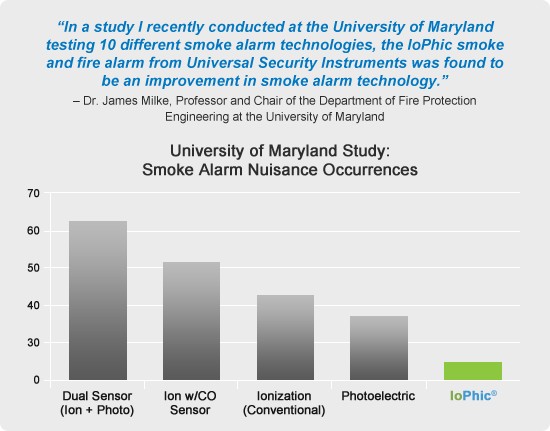New Smoke Alarm Technology - The USST Smart Alarm
With so many choices for smoke alarms on the market, it can be confusing when trying to choose the right one. The NEW Universal Smoke Sensing Technology (USST)® smoke and fire alarm from Universal Security Instruments solves that problem. Originally named IoPhic, these are the only alarms with patented microprocessor technology that helps eliminate dangerous nuisance alarms.
What is Universal Smoke Sensing Technology Smart Technology?
These new smoke alarms are very effective at detecting fast flaming fires and also respond very quickly to slow smoldering fires - up to 87 percent faster* than the maximum allowable alarm limit.
Universal Smoke Sensing smoke and fire alarms have a new smart technology that uses a patented microprocessor to help to distinguish nuisance alarms from a real fire and provide the most accurate detection results to keep families safe.
Why choose Universal Smoke Sensing Technology for my home?
Fires can double in size in as little as 30 seconds, so the smart microprocessor technology, included in these detectors, respond quickly to give you the extra time to react and protect your family.
Unlike other smoke alarms, Universal Smoke Sensing smoke and fire alarms are ideal for every room in the home. According to the NFPA, smoke alarms should be installed in every sleeping room, outside each separate sleeping area, and on every level of the home.
Download the Universal Smoke Sensing brochure to learn more about its benefits
Backed By University Research
A recent study from the University of Maryland's School of Fire Protection Engineering tested the nuisance alarm resistance of the new Universal Smoke Sensing technology. The study results confirmed the new IoPhic line of smoke and fire alarms using smart technology from Universal Security Instruments are more resistant to nuisance alarms.
Based on the results of this test series, Universal Smoke Sensing based smoke and fire alarms are observed to have nominally equivalent nuisance alarm immunity to photoelectric smoke alarms in kitchen scenarios, and are more resistant to nuisance sources near bathrooms than photoelectric smoke alarms. They are more resistant to nuisance alarms than all other smoke alarms utilizing an ionization sensor.
Download the study summary here


 A recent study from the University of Maryland's School of Fire Protection Engineering tested the nuisance alarm resistance of the new Universal Smoke Sensing technology. The study results confirmed the new IoPhic line of smoke and fire alarms using smart technology from Universal Security Instruments are more resistant to nuisance alarms.
A recent study from the University of Maryland's School of Fire Protection Engineering tested the nuisance alarm resistance of the new Universal Smoke Sensing technology. The study results confirmed the new IoPhic line of smoke and fire alarms using smart technology from Universal Security Instruments are more resistant to nuisance alarms.